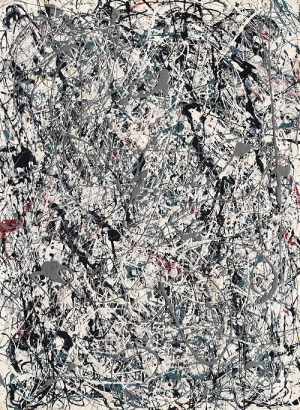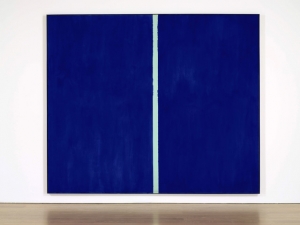|
Displaying items by tag: color field painting
A single act of generosity by a collector and supporter of The Nelson-Atkins Museum of Art in Kansas City has resulted in the gifting of five more works of art, a handful of loans, and an installation celebrating Color Field painting. Luther W. Brady, M.D., one of the world’s foremost oncologists, gifted the museum with Jules Olitski’s Embraced: Yellow and Black, in the memory of his dear friend Joanne Lyon, a longtime supporter of the Nelson-Atkins. Inspired by that gift, an anonymous donor loaned the Nelson-Atkins Helen Frankenthaler’s Elberta, another quintessential example of Color Field painting.

On Friday, February 6, 2015, the Blanton Museum of Art announced that it will acquire and construct Ellsworth Kelly’s only building. Kelly, an American painter, sculptor, and printmaker associated with Color Field painting, hard-edge painting, and Minimalism, conceived the stand-alone structure in 1986 for a private collector. At the age of 91, he is finally seeing the project come to fruition.
Austin, a 73-by-60-foot stone building, will be constructed on the museum’s grounds at the University of Texas at Austin. The structure will feature luminous colored glass windows, a totemic wood sculpture, and fourteen black-and-white stone panels in marble -- all designed by the artist. Kelly has gifted the Blanton the design concept for the work, including the building, the totem sculpture, the interior panels, and the glass windows. Once it is complete, Austin will become part of the museum’s permanent collection. The Blanton has launched a campaign to raise $15 million to realize the project and has received commitments totaling $7 million.
The Asheville Art Museum will present “What You See Is What You See: American Abstraction After 1950,” on view Nov. 28-March 15. This vivid and dynamic exhibition considers the phases of color field painting from the 1950s through the 1980s.
Beginning in the late 1950s, art critic Clement Greenberg noted a tendency toward all-over color — or color field — in the works of several of the first generation abstract expressionists such as Mark Rothko and Clyfford Still.
Color Field painting arrived, in the late 1950s, at a moment of simultaneous exhaustion and innovation: fatigue with the Abstract Expressionist hegemony on the one hand, and radical new developments in paint chemistry on the other.
These forces conspired in a movement to make paintbrushes superfluous and to give color, the essence of painting, even more primacy. As the critic and Color Field champion Clement Greenberg put it, “The more closely color could be identified with its ground, the freer would it be from the interference of tactile associations.”
A new exhibition at the Princeton University Art Museum in New Jersey charts the developments in abstract painting that took place between 1950 and 1990. The show examines how postwar artists such as Josef Albers, Willem de Kooning, Richard Diebenkorn, Jean Dubuffet, Helen Frankenthaler, Hans Hofmann, Franz Kline, Morris Louis, Robert Motherwell, Robert Rauschenberg, Gerhard Richter, Mark Rothko, and Frank Stella ushered in advancements in abstraction thanks to their individual approaches to line, color, and form.
“Rothko to Richter: Mark-Making in Abstract Painting” presents nearly thirty paintings on loan from the collection of Preston H. Haskell III, a Princeton University alumnus and a longstanding Museum benefactor. The exhibition touches on a number of monumental movements, including Abstract Expressionism, Color Field painting, Minimalism, Op art, and Postmodernism.
Ellsworth Kelly (b. 1933), a pioneer of American abstract art, will receive a National Medal of Arts from President Obama July 10, 2013 at the White House. The National Medal is the highest honor given to artists and art patrons by the U.S. government.
Kelly, a painter, sculptor and printmaker, began developing his unique approach to minimalism, color field painting and hard-edge painting in the 1950s. By the end of the decade, he had established himself as an important figure in the art world and three of his pieces were selected for the Whitney Museum of American Art’s seminal exhibition Young America 1957. Since setting himself apart from his peers thanks to his innovative style, Kelly has been lauded for his ability to pull abstract form, contour and color contrast from perceived reality.
Kelly, who turned 90 this year, is currently the subject of the exhibition Ellsworth Kelly: Chatham Series, which is on view at the Museum of Modern Art in New York through September 8, 2013.

Christie’s Post-War and Contemporary Evening Art Auction on May 15, 2013 in New York garnered $495 million – the highest total in auction history. Packed with masterpieces from an array of important art movements including Abstract Expressionism and Pop, many of the works offered were from lauded private collections and institutions. Brett Gorvy, Chairman and International Head of Post-War and Contemporary Art, said, “The remarkable bidding and record prices set reflect a new era in the art market, wherin seasoned collectors and new bidders compete at the highest level within a global market.”
The top lot of the night was Jackson Pollock’s (1912-1956) Number 19, 1948 (estimate: $25 million - $35 million). A prime example of Pollock’s drip paintings, the work sold for $58.3 million and set the record for the artist at auction. The influential art critic, Clement Greenberg, singled our Number 19 as the painting that offered enough proof to justify calling Pollock one of the most significant painters of our time.
Other highlights include Roy Lichtenstein’s (1923-1997) iconic work of pop art, Woman with Flowered Hat (1963) (estimate: approximately $30 million), which sold for $56.1 million and set the record for the artist at auction; Jean Michel-Basquiat’s (1960-1988) Dustheads (estimate: $25 million - $35 million), a neo-expressionist work from the 1980s, which sold for $48.8 million, an auction record for the artist; and Mark Rothko’s (1903-1970) color field painting, Untitled (Black on Maroon) (1958) (estimate: $15 million-$20 million), which sold for $27 million.
Out of 70 works offered at last night’s auction, only 4 failed to find buyers.

Sotheby’s evening sale of Contemporary Art, which took place on Tuesday, May 14, 2013 in New York, saw a number of exceptional works sell for record-breaking prices. The night’s top lot was Barnett Newman’s (1905-1970) Onement VI, an iconic Abstract Expressionist painting, which garnered $43.8 million. The work exceeded its high estimate of $40 million and set an auction record for Newman. The dark blue canvas, which measures 8 ½ feet x 10 feet and is sliced down the middle by a pale blue streak, is a remarkable example of Newman’s association with abstract expressionism as well as color field painting.
Other highlights from the sale included Gerhard Richter’s (b. 1932) oil painting of Milan’s cathedral square, Domplatz, Mailand (estimate: $30 million-$40 million), which sold for $37.1 million and set a record for Richter as well as for any living artist at auction; a sculpture by Yves Klein (1928-1962), which sold for $22 million and broke the record for the artist at auction; and Clyfford Still’s (1904-1980) PH-12, which was estimated to sell for $16 million to $20 million and ended up going for $20.9 million.
Although there were a number of high-profile sales, the auction was not without some failures. Francis Bacon’s (1909-1992) Study for Portrait of P.L., which was expected to bring $30 million $40 million didn’t find a buyer. Two works by Jeff Koons (b. 1955) also failed to sell.
The auction happenings will continue in New York at Christie’s, where Post-War and Contemporary sales will be held through the afternoon of Thursday, May 16, 2013.

A monumental mural by Ellsworth Kelly (b. 1923), an American painter and sculptor often associated with color field painting and the Minimalist movement has found a temporary home at the Barnes Foundation just outside of Philadelphia.
The Barnes, an educational art institution, is currently hosting the exhibition Sculpture on the Wall, which includes Kelly’s Sculpture for a Large Wall. Created between 1956 and 1957, the work was commissioned for the Philadelphia Transportation Building and it was the first public abstract sculpture in Philadelphia. The work was removed from the Transportation Building after it closed in 1993 and was later acquired by Ronald S. Lauder, the former chairman of the Museum of Modern Art. Lauder and his wife promptly donated the work to MoMA where it has only been exhibited twice.
Sculpture for a Large Wall, which measures over 65 feet long and 11 feet high, is accompanied by four other works from later in Kelly’s career including the geometric Red Curve (1986) and the minimalist Two Curves (2012). The sculptures will be on view at the Barnes Foundation through September 2, 2013.

Sotheby’s Contemporary Art Evening Sale on May 14, 2013 in New York will include one of the most important paintings by Barnett Newman (1905-1970) ever to appear at auction. Onement VI (1953) is a seminal work by the American artist and one of the most significant pieces from the Abstract Expressionist movement. The painting, which measures 8 ½ feet x 10 feet, is expected to garner anywhere from $30 million to $40 million. The canvas will go on view at Sotheby’s on May 3, 2013 until it appears at auction later that month.
Newman, one of the foremost artists of the 20th century, was a pioneer of color field painting as well as a key Abstract Expressionist. As an exhibitions organizer at the Manhattan-based Betty Parsons Gallery in the 1940s, Newman played a fundamental role in the careers of many of his friends including Mark Rothko (1903-1970), Jackson Pollock (1912-1956), and Clyfford Still (1904-1980).
Onement VI, a massive canvas consumed by rich blue paint and sliced down the middle by a light blue streak, was a gift from the artist to his wife, Annalee. The painting remained in her collection for almost a decade and was acquired in 1961 by the well-known collectors Frederick and Marcia Weisman. That same year the painting appeared in an exhibition titled Abstract Expressionists Imagists at the Solomon R. Guggenheim Museum that helped define the modern art movement.
Onement VI is the final work in a series of six paintings by Newman. Four of the paintings are held in major art institutions including the Museum of Modern Art in New York, the Wadsworth Atheneum Museum of Art in Hartford, CT, and the Allen Memorial Art Museum in Oberlin, OH. Onement V currently resides in a private collection.
|
|
|
|
|